May 31, 2010
Written by C.N.
New Books: Diverse Forms of Asian American Heritage
As part of this blog’s mission of making academic research and data more easily accessible, understandable, and applicable to a wider audience and to practical, everyday social issues, I highlight new sociological books about Asian Americans and other racial/ethnic groups as I hear about them. A book’s inclusion is for informational purposes only and does not necessarily mean a full endorsement of its complete contents.
As we prepare to close May as Asian Pacific American Heritage Month, the following recently released books describe a wide and interesting range of experiences, contributions, and legacies that are part of Asian American heritage, and how this heritage fits into the larger American mainstream.
Asian Americans in the Twenty-First Century: Oral Histories of First- to Fourth-Generation Americans from China, Japan, India, Korea, the Philippines, Vietnam, and Laos, by Joann Lee (New Press)
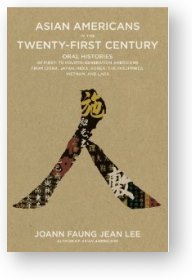
The collective term “Asian American” comprises more than twenty distinct nationalities and ethnic groups, and today there are more than 12 million Asian Pacific Americans living in the United States. In this all-new collection of fascinating interviews with students, lawyers, engineers, politicians, stay-at-home moms, and activists, Joann Faung Jean Lee again draws upon her great skill and sensitivity as a journalist to reveal a rich mosaic of Asian American identities.
We hear a range of voices: Dale Minami recounts his historic involvement in a landmark legal case that changed the way America understands the internment of Japanese Americans during World War II; Ruby Chow remembers how she used her position as a beloved restaurateur to launch a successful campaign for county councilwoman in Seattle, Washington; and Daniel Jung speaks of the complexities of African American and Korean relations in Los Angeles, where his father owned a liquor store when Daniel was a teenager in the 1990s.
Candid and compelling, the interviews reveal intimate and often conflicting thoughts about Asian American identities, immigration, family, relationships, and educational and professional achievement.
Encyclopedia of Asian American Issues Today, edited by Edith Wen-Chu Chen and Grace J. Yoo (Greenwood Press)
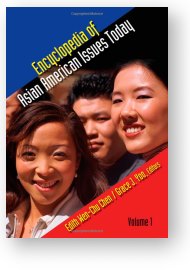
Encyclopedia of Asian American Issues Today is the first major reference work focused on the full expanse of contemporary Asian American experiences in the United States. Drawing on over two decades of research, it takes an unprecedented look at the major issues confronting the Asian American community as a whole, and the specific ethnic identities within that community — from established groups such as Chinese, Japanese, and Korean Americans to newer groups such as Cambodian and Hmong Americans.
Across two volumes, Encyclopedia of Asian American Issues Today offers 110 entries on the current state of affairs, controversies, successes, and outlooks for future for Asian Americans. The set is divided into 11 thematic sections including diversity and demographics; education; health; identity; immigrants, refugees, and citizenship; law; media; politics; war; work and economy; youth, family, and the aged. Contributors include leading experts in the fields of Asian American studies, education, public health, political science, law, economics, and psychology.
The Shifting Grounds of Race: Black and Japanese Americans in the Making of Multiethnic Los Angeles, by Scott Kurashige (Princeton University Press)
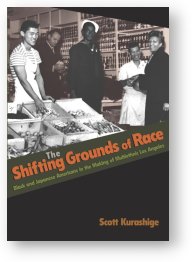
Los Angeles has attracted intense attention as a “world city” characterized by multiculturalism and globalization. Yet, little is known about the historical transformation of a place whose leaders proudly proclaimed themselves white supremacists less than a century ago. In The Shifting Grounds of Race, Scott Kurashige highlights the role African Americans and Japanese Americans played in the social and political struggles that remade twentieth-century Los Angeles.
Linking paradigmatic events like Japanese American internment and the Black civil rights movement, Kurashige transcends the usual “black/white” dichotomy to explore the multiethnic dimensions of segregation and integration. Racism and sprawl shaped the dominant image of Los Angeles as a “white city.” But they simultaneously fostered a shared oppositional consciousness among Black and Japanese Americans living as neighbors within diverse urban communities.
Kurashige demonstrates why African Americans and Japanese Americans joined forces in the battle against discrimination and why the trajectories of the two groups diverged. Connecting local developments to national and international concerns, he reveals how critical shifts in postwar politics were shaped by a multiracial discourse that promoted the acceptance of Japanese Americans as a “model minority” while binding African Americans to the social ills underlying the 1965 Watts Rebellion. Multicultural Los Angeles ultimately encompassed both the new prosperity arising from transpacific commerce and the enduring problem of race and class divisions.
This extraordinarily ambitious book adds new depth and complexity to our understanding of the “urban crisis” and offers a window into America’s multiethnic future.
Partly Colored: Asian Americans and Racial Anomaly in the Segregated South, by Leslie Bow (New York University Press)
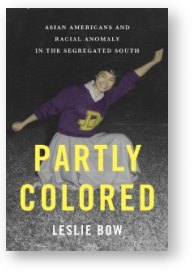
Arkansas, 1943. The Deep South during the heart of Jim Crow-era segregation. A Japanese-American person boards a bus, and immediately is faced with a dilemma. Not white. Not black. Where to sit?
By elucidating the experience of interstitial ethnic groups such as Mexican, Asian, and Native Americans—groups that are held to be neither black nor white — Leslie Bow explores how the color line accommodated — or refused to accommodate — “other” ethnicities within a binary racial system. Analyzing pre- and post-1954 American literature, film, autobiography, government documents, ethnography, photographs, and popular culture, Bow investigates the ways in which racially “in-between” people and communities were brought to heel within the South’s prevailing cultural logic, while locating the interstitial as a site of cultural anxiety and negotiation.
Spanning the pre- to the post- segregation eras, Partly Colored traces the compelling history of “third race” individuals in the U.S. South, and in the process forces us to contend with the multiracial panorama that constitutes American culture and history.
Cultural Citizenship and Immigrant Community Identity: Constructing a Multi-Ethnic Asian American Community, by Hye-Kyung Kang (LFB Scholarly Publishing)
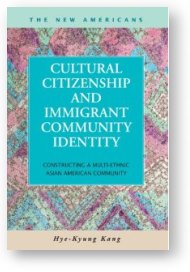
Kang explores cultural citizenship and immigrant community identity development in the International District (ID) of Seattle, WA. She investigates the particular social, political, and historical contexts within which a “multi-ethnic Asian American community” identity arose.
She finds that the ID as a subject is produced and sustained not through a singular identity but through multiple and contingent discourses of history, contribution, and change. Similarly, it is constructed through a constant processes of engagement, contestation and negotiation between the community and the various larger social and political structures of society, as well as among community members. The results suggest that it may be possible for immigrant subjects to alter the discourses that constitute them by generating counter-discourses.
Asian American Chronology: Chronologies of the American Mosaic, by Xiaojian Zhao (Greenwood Press)
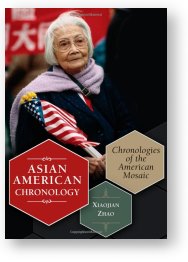
Understanding the history of Asians in America is key to understanding the development of America itself. Asian American Chronology: Chronologies of the American Mosaic presents the most influential events in Asian American history as well as key moments that have remained under the historical radar. This in-depth record covers events from the 18th century to the present day, including the 2008 Olympic Games in Beijing.
Entries, organized chronologically by category, allow readers to trace the development of Asian peoples and culture in the United States over time, including the role of Chinese labor in building railroads, the importation of Filipino slaves, labor strikes and civil rights issues, Japanese-American internment, women’s roles, literature, music, politics, and increased immigration in the mid-20th century.
In addition to these broad topics, the book also treats individual events from the Rock Springs Massacre to the Gold Rush to the current prevalence of Japanese players in Major League Baseball.

